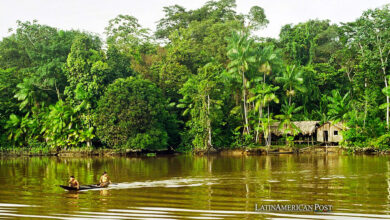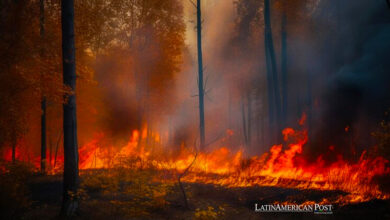Sustainable forest management: cutting trees and preserving the forest
Given the fact that trees grow every year, the extraction of a volume smaller than timber production allows the forest to be preserved in the long term.

View of trees in a forest. / Photo: Unsplash
LatinAmerican Post | Jorge Guasp
Listen to this article
Leer en español: Manejo forestal sustentable: cortar árboles y preservar el bosque
Forests constitute a renewable natural resource. Given the fact that trees grow every year, and this increase can be measured, the extraction of a volume smaller than timber production allows the forest to be preserved in the long term.
How do you measure the growth of a forest?
When a log is cut transversely, clearly visible and concentric circles can be seen in the log: they are the growth rings. If a ring is compared with that of the previous year, the basal area or trunk diameter growth can be calculated. If this value is multiplied by the height of the tree, an increase in the volume of an average tree is obtained. That annual growth, expressed in units of volume and multiplied by the number of existing trees per hectare, yields the data of the cubic meters per hectare and per year that a forest grows on average.
What information is needed to extract wood from a forest?
The FAO Toolkit for Sustainable Forest Management (Food and Agriculture Organization of the Nations) states that “decisions on the types and objectives of silvicultural treatments to be applied in an area of exploitation (for example, a block or compartment) should be based on the condition of the forest, such as the existence or absence of an adequate quantity and distribution of trees of desirable species to constitute the next harvest, the response of desirable species to different light conditions and other factors which can favor or prevent the growth of trees. Generally, forest inventories, in which data are collected on the abundance and the diametric distribution of the species of interest and the total basal area in the corresponding forest types, for example, are essential for making such decisions. ”
What alternatives exist for the management of a forest?
Forest management methods fall into two broad categories: those destined for a regular forest (with trees of uniform age), and those applied to an irregular forest (with trees of different ages).
Regular forests (with trees of similar age) are generally subjected to clearcut cutting (total clearing of an area and repopulation with seeds from adjacent areas), parent trees (large specimens that provide seeds to regenerate the forest are left) and successive cuts (the remaining trees protect the rest of the forest from wind, erosion and other factors, and provide seeds).
Irregular forests (with trees of different ages), on the other hand, are used mainly through short selection: isolated individuals are extracted or small forests or strips of specimens, which are selected for their characteristics. This method favors the repopulation and maintains the irregular characteristics (trees of different ages) of the forest mass.
Also read: Capturing CO2 from trucks and reducing their emissions by 90%
How to know if the wood comes from a forest managed responsibly?
“The FSC (Forest Stewardship Council) is a global non-profit organization dedicated to promoting responsible forest management worldwide” (Forests for all forever, FCS website in Spanish). This environmental seal was born in California, United States, in 1990, within a group of companies linked to the commercialization of wood, and representatives of environmental and human rights organizations, concerned with deforestation, environmental degradation, and social exclusion.
According to the organization itself, “environmentally appropriate forest management guarantees that the way in which the use of wood and non-timber products is carried out contributes to maintaining the biodiversity, productivity and ecological processes of the forest.” All products that come from These certified forests carry the FSC label.
Preserving the forest is respecting life and environmental services
Although forest management implies a series of knowledge and techniques that are impossible to cover in an article, there are some premises that we can keep in mind for future generations to receive forests in good condition:
- Do not extract all the wood that the forest produces annually, in order to ensure its survival.
- Do not remove only the best trees, because in this way the forest is impoverished.
- Prevent the accumulation of forest remains (branches and leaves), which represent the fuel of potential fires.
- Reduce damage to forest regeneration during tree attachment operations.
- Prevent erosion of forest roads during logging operations.
- Contemplate the ecological needs of the human and wildlife communities that live in the forest, and not only the commercial revenue from timber extraction.
The forest is not a group of trees but a network of delicate ecological relationships, which must be respected if we want forest ecosystems to remain a source of environmental goods and services, without which our survival will be at risk.




